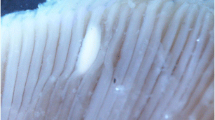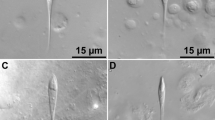Abstract
A Henneguya sp., morphologically resembling Henneguya nyongensis Fomena & Bouix, 1996, was isolated from the gills of Peter’s elephantnose fish, Gnathonemus petersii Günther, imported from Nigeria. Plasmodia were located between lamellae and within the gill epithelium, often leading to lamellar fusion. Although slightly smaller, the myxospores from these fish were morphologically consistent with H. nyongensis. In valvular view, spores are elongate, pyriform with a rounded posterior and tapering caudal processes. Myxospore bodies are 9.6–12.3 (mean 11.2) µm long and 4.0–4.7 (mean 4.3) µm wide. Polar capsules are pyriform, elongate, 4.5–5.2 (4.7) µm long and 1.3–1.6 (1.4) µm wide, with a characteristic neck-like structure at the apical end. Sequence generated for the 18S small subunit rRNA gene did not directly match any sequences available on GenBank, but demonstrated 91% nucleotide similarity to an unpublished Henneguya sp. infecting Mormyrus kannume Forsskål. Herein, the description of H. nyongensis is supplemented with new data on histopathology, molecular characterisation, and expanded host and geographical range.




Similar content being viewed by others
References
Alama-Bermejo, G., Jirků, M., Kodádková, A., Pecková, H., Fiala, I., & Holzer, A. S. (2016). Species complexes and phylogenetic lineages of Hoferellus (Myxozoa, Cnidaria) including revision of the genus: A problematic case for taxonomy. Parasites & Vectors,9, 13.
Altschul, S. F., Gish, W., Miller, W., Myers, E. W., & Lipman, D. J. (1990). Basic local alignment search tool. Journal of Molecular Biology,215, 403–410.
Barta, J. R., Marin, D. S., Liberator, P. A., Dshkevicz, M., Anderson, J. W., Feighner, S. D., et al. (1997). Phylogenetic relationships among eight Eimeria species infecting domestic fowl inferred using complete small subunit ribosomal DNA sequences. Journal of Parasitology,83, 262–271.
Bellerud, B. L., Pote, L. M., Lin, T. L., Johnson, M. J., & Boyle, C. R. (1995). Etiological and epizootological factors associated with outbreaks of proliferative gill disease in channel catfish. Journal of Aquatic Animal Health,7, 124–131.
Caffara, M., De Vita, V., Florio, D., Gustinelli, A., Quaglio, F., & Fioravanti, M. L. (2007). Infections due to Unicauda spp. (Myxozoa, Myxobolidae) in elephantnose fish (Gnathonemus petersii) imported to Italy. Bulletin of the European Association of Fish Pathologists,27, 142–147.
Declercq, A. M., Haesebrouck, F., Van den Broeck, W., Bossier, P., & Decostere, A. (2013). Columnaris disease in fish: A review with emphasis on bacterium-host interactions. Veterinary Research,44, 27.
Dohle, A., Schmahl, G., Raether, W., Schmidt, H., & Ritter, G. (2002). Effects of orally administered chemotherapeutics (quinine, salinomycin) against Henneguya sp. Thélohan, 1892 (Myxozoa: Myxobolidae), a gill parasite in the tapir fish Gnathonemus petersii Gunther, 1862 (Teleostei). Parasitology Research,88, 861–867.
Fevre, E. M., Bronsvoort, B. M., Hamilton, K. A., & Cleaveland, S. (2006). Animal movements and the spread of infectious diseases. Trends in Microbiology,14, 125–131.
Felsenstein, J. (1985). Confidence limits on phylogenies: an approach using the bootstrap. Evolution,39, 783–791.
Fiala, I., Bartošová-Sojková, P., & Whipps, C. M. (2015). Classification and phylogenetics of Myxozoa. In: Okamura, B., Gruhl, A. & Bartholomew, J. L. (Eds), Myxozoan evolution, ecology and development. Cham: Springer. pp. 85–110.
Fomena, A., & Bouix, G. (1994). New Myxosporidea species (Myxozoa) from freshwater teleosts in southern Cameroon (Central Africa). Journal of African Zoology,108, 481–491.
Fomena, A., & Bouix, G. (1996). New species of Henneguya Thélohan, 1892 (Myxozoa: Myxosporea) parasites of freshwater fishes in Cameroon. Journal of African Zoology,110, 413–423.
Go, J., Lancaster, M., Deece, K., Dhungyel, O., & Whittington, R. (2006). The molecular epidemiology of iridovirus in Murray cod (Maccullochella peelii peelii) and dwarf gourami (Colisa lalia) from distant biogeographical regions suggests a link between trade in ornamental fish and emerging iridoviral diseases. Molecular & Cellular Probes,20, 212–222.
Griffin, M. J., Pote, L. M., Wise, D. J., Greenway, T. E., Mauel, M. J., & Camus, A. C. (2008). A novel Henneguya species from channel catfish described by morphological, histological and molecular characterization. Journal of Aquatic Animal Health,20, 127–135.
Hallett, S. L., Atkinson, S. D., Erseus, C., & El-Matbouli, M. (2005). Dissemination of triactinomyxons (Myxozoa) via oligochaetes used as live food for aquarium fishes. Diseases of Aquatic Organisms,65, 137–152.
Hallett, S. L., & Diamant, A. (2001). Ultrastructure and small-subunit ribosomal DNA sequence of Henneguya lesteri n. sp. (Myxosporea), a parasite of sand whiting Sillago analis (Sillaginidae) from the coast of Queensland. Australia. Diseases of Aquatic Organisms,46, 197–212.
Hanson, L. A., Lin, D., Pote, L. M., & Shivaji, R. (2001). Small subunit rRNA gene comparisons of four actinosporean species to establish a polymerase chain reaction test for the causative agent of proliferative gill disease in channel catfish. Journal of Aquatic Animal Health,13, 117–123.
Hedrick, R. P., Wishkovsky, A., Modin, J. C., & Toth, R. J. (1991). Three myxosporeans found in the cranial and branchial tissues of rainbow trout in California. Journal of Aquatic Animal Health,3, 55–62.
Katoh, K., Misawa, K., Kuma, K., & Miyata, T. (2002). MAFFT: A novel method for rapid multiple sequence alignment based on fast Fourier transform. Nucleic Acids Research,30, 3059–3066.
Katoh, K., & Standley, D. M. (2013). MAFFT multiple sequence alignment software version 7: Improvements in performance and usability. Molecular Biology and Evolution,30, 772–780.
Kent, M. L., Khattra, J., Hedrick, R. P., & Devlin, R. H. (2000). Tetracapsula renicola n. sp. (Myxozoa: Saccosporidae); the PKX myxozoan - the cause of proliferative kidney disease of salmonid fishes. Journal of Parasitology,86, 103–111.
Kostoïngue, B., Diebakate, C., Faye, N., & Toguebaye, B. S. (2001). Presence of Myxosporidea (Myxozoa: Myxosporea) of the genus Henneguya Thélohan in freshwater fishes from Chad (Central Africa). Acta Protozoologica,40, 117–123.
Kumar, S., Stecher, G., & Tamura, K. (2016). MEGA7: Molecular evolutionary genetics analysis version 7.0 for bigger datasets. Molecular Biology and Evolution,33, 1870–1874.
Lom, J., & Arthur, M. C. (1989). A guideline for the preparation of species descriptions in Myxosporea. Journal of Fish Diseases,12, 151–156.
Mrugala, A., Kozubikova-Balcarova, E., Chucholl, C., Cabanillas Resino, S., Viljamaa-Dirks, S., Vukic, J., et al. (2015). Trade of ornamental crayfish in Europe as a possible introduction pathway for important crustacean disease: crayfish plague and white spot syndrome. Biological Invasions,17, 1313–1326.
Nei, M., & Kumar, S. (2000). Molecular evolution and phylogenetics. New York: Oxford University Press.
Noga, E. J. (2010). Fish disease diagnosis and treatment. Ames, IA: Wiley-Blackwell.
Parker, J. D., & Warner, M. C. (1970). Effects of fixation, dehydration, and staining on dimensions of myxosporidian and microsporidian spores. Journal of Wildlife Diseases,6, 448–456.
Peeler, E. J., Oidtmann, B. C., Midtlyng, P. J., Miossec, L., & Gozlan, R. E. (2011). Non-native aquatic animals introductions have driven disease emergence in Europe. Biological Invasions,13, 1291–1303.
Ronquist, F., & Huelsenbeck, J. P. (2003). MRBAYES 3: Bayesian phylogenetic inference under mixed models. Bioinformatics,19, 1571–1574.
Rosser, T. G., Khoo, L. H., Pote, L. M., & Griffin, M. J. (2016). Verrucous dermal henneguyosis associated with Henneguya exilis (Kudo, 1929) (Cnidaria: Myxobolidae), a parasite of the channel catfish Ictalurus punctatus (Rafinesque, 1818). Journal of Fish Diseases,39, 1263–1267.
Schmahl, G., Senaud, J., & Mehlhorn, H. (1991). Treatment of fish parasites 8. Effects of sym. Triazinone (toltrazuril) on developmental stages of Henneguya sp. (Myxozporea, Myxozoa): a light and electron microscopic study. Archiv für Protistenkunde,140, 83–94.
Stilwell, J. M., Camus, A. C., Leary, J. H., Khoo, L. H., & Griffin, M. J. (2019). Pathologic changes associated with respiratory compromise and morbidity due to massive interlamellar Henneguya exilis infection in channel × blue hybrid catfish. Journal of Parasitology,105, 686–692.
Trujillo-Gonzalez, A., Becker, J. A., & Hutson, K. S. (2018). Parasite dispersal from the ornamental goldfish trade. Advances in Parasitology,100, 239–281.
Wagner, E. J. (2016). A Guide to the identification of tailed Myxobolidae of the world: Dicauda, Hennegoides, Henneguya, Laterocapsulata, Neohenneguya, Phlogospora, Tetrauronema, Trigonosporus, and Unicauda. Logan, Utah: Fish Creek Records.
Whittington, R. J., & Chong, R. (2007). Global trade in ornamental fish from an Australian perspective: the case for revised import risk analysis and management strategies. Preventive Veterinary Medicine,81, 92–116.
Wise, D. J., Camus, A. C., Schwedler, T. E., & Terhune, J. S. (2004). Health management. In: Tucker, C. S. & Hargreaves, J. A. (Eds), Biology and culture of channel catfish (pp. 444–498). Amsterdam: Elsevier B. V.
Wise, D. J., Griffin, M. J., Terhune, J. S., Pote, L. M., & Khoo, L. H. (2008). Induction and evaluation of proliferative gill disease in channel catfish fingerlings. Journal of Aquatic Animal Health,20, 236–244.
Author information
Authors and Affiliations
Corresponding author
Ethics declarations
Conflict of interest
The authors declare that they have no conflict of interest.
Ethical approval
All applicable institutional, national and international guidelines for the care and use of animals were followed.
Additional information
Publisher's Note
Springer Nature remains neutral with regard to jurisdictional claims in published maps and institutional affiliations.
Rights and permissions
About this article
Cite this article
Stilwell, J.M., Stilwell, N.K., Camus, A.C. et al. A morphological, molecular, and histopathological redescription of Henneguya nyongensis Fomena & Bouix, 1996 (Cnidaria: Myxobolidae) infecting the gills of Peter’s elephantnose fish, Gnathonemus petersii (Günther) (Osteoglossiformes: Mormyridae), imported from Nigeria. Syst Parasitol 96, 767–776 (2019). https://doi.org/10.1007/s11230-019-09887-3
Received:
Accepted:
Published:
Issue Date:
DOI: https://doi.org/10.1007/s11230-019-09887-3




